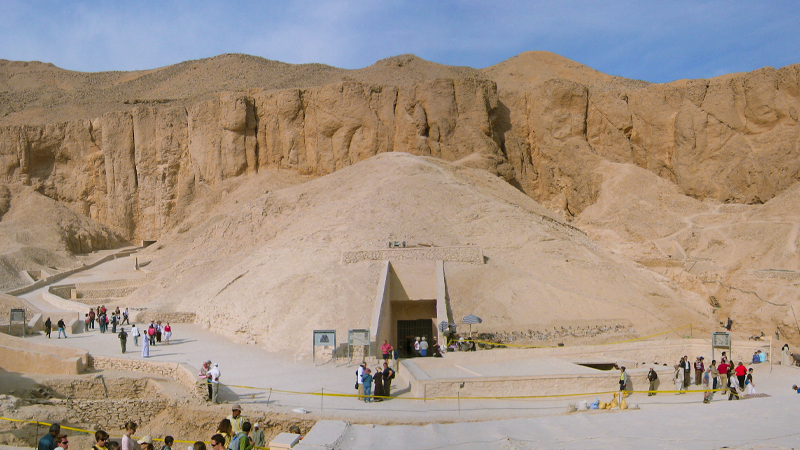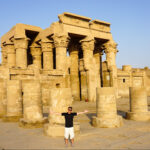Welcome to the enthralling journey through the Valley of the Kings Next to Hatshepsut Temple – a fascinating archaeological marvel nestled on the western bank of the Nile River in Luxor, Egypt. This historical treasure trove, known for its intricate tombs and royal heritage, offers a captivating glimpse into the ancient Egyptian civilization. In this comprehensive article, we’ll traverse the enigmatic corridors of the Valley of the Kings, exploring its significance, grandeur, and the mysteries that continue to intrigue explorers and historians alike.
Valley of the Kings: A Glimpse into Ancient Egypt’s Royalty
The Valley of the Kings, often referred to as “Biban el-Moluk” in Arabic, was the sacred burial ground of Pharaohs and powerful nobles during the New Kingdom period (approximately 16th to 11th century BC). Situated on the barren desert landscape, this necropolis boasts a collection of elaborately designed tombs that served as final resting places for these illustrious figures.

Unraveling the Mysteries: Tombs and Architecture
The tombs within the Valley of the Kings stand as architectural marvels, designed with intricate carvings, paintings, and passages. These underground complexes were meticulously constructed to ensure safe passage to the afterlife for the entombed royalty. Each tomb is a unique testament to the belief in the afterlife and the grandeur of the Pharaohs.
Architectural Diversity in Tombs
From the beautifully adorned tomb of Pharaoh Tutankhamun to the awe-inspiring grandeur of Ramses II’s burial site, each grave presents a distinct architectural style and narrative. The walls depict scenes from mythology, rituals, and daily life, providing a window into the culture and beliefs of ancient Egypt.
Paintings that Transcend Time
The vibrant and well-preserved paintings adorning the tomb walls vividly portray ancient Egyptian society. These masterful artworks showcase the Pharaohs’ journey to the afterlife, the deities that guided them, and the rituals that ensured a successful transition.
Hidden Treasures and Discoveries
Over the years, archaeologists have unearthed countless artifacts and treasures within the Valley of the Kings. These findings provide valuable insights into ancient Egypt’s customs, technologies, and craftsmanship. Notable discoveries include intricate jewelry, ceremonial artifacts, and ornate sarcophagi.
Modern Discoveries and Ongoing Research
Despite decades of exploration, the Valley of the Kings continues to reveal its secrets through ongoing research and technological advancements. Archaeologists and historians employ cutting-edge techniques to uncover hidden chambers, decode hieroglyphics, and gain deeper insights into the lives of the Pharaohs and their subjects.

FAQs about the Valley of the Kings
What is the significance of the Valley of the Kings?
The Valley of the Kings holds immense historical and cultural importance as the final resting place of prominent Pharaohs and nobles. It provides a unique perspective on ancient Egyptian beliefs and rituals related to the afterlife.
How many tombs are there in the Valley of the Kings?
There are currently 63 known tombs in the Valley of the Kings, each varying in size, design, and historical significance.
Can visitors explore the tombs?
Yes, a selection of vaults is open to the public. However, some burials may be periodically closed for restoration to preserve delicate artworks and structures.
What is the most famous tomb in the Valley?
The tomb of King Tutankhamun (KV62) is arguably the most famous, renowned for the incredible treasures and artifacts discovered within.
Are all tombs equally accessible to tourists?
No, the accessibility of graves varies. While some are open year-round, others may have restricted entry to ensure their preservation.
How can I visit the Valley of the Kings?
Visitors can access the Valley of the Kings as part of guided tours or independently. Checking with local authorities or tour operators for the latest information on visiting arrangements is recommended.
Conclusion
The Valley of the Kings is a testament to ancient Egypt’s timeless allure. Its intricately designed tombs, rich history, and ongoing research efforts offer an unparalleled opportunity to journey through the epochs and connect with the Pharaohs who once ruled this majestic land. Whether you’re an avid historian, an explorer of mysteries, or a curious traveler, the Valley of the Kings promises an unforgettable experience that resonates across the ages.




